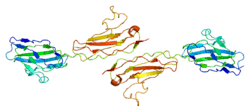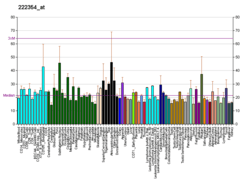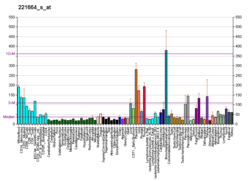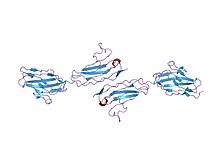F11 receptor
Junctional adhesion molecule A is a protein that in humans is encoded by the F11R gene.[5][6][7] It has also been designated as CD321 (cluster of differentiation 321).
Function
Tight junctions represent one mode of cell-to-cell adhesion in epithelial or endothelial cell sheets, forming continuous seals around cells and serving as a physical barrier to prevent solutes and water from passing freely through the paracellular space. The protein encoded by this immunoglobulin superfamily gene member is an important regulator of tight junction assembly in epithelia. In addition, the encoded protein can act as (1) a receptor for reovirus, (2) a ligand for the integrin LFA1, involved in leukocyte transmigration, and (3) a platelet receptor. Multiple transcript variants encoding two different isoforms have been found for this gene.[7]
Interactions
F11 receptor has been shown to interact with MLLT4,[8] CASK[8][9] and Tight junction protein 1.[8][10]
References
- GRCh38: Ensembl release 89: ENSG00000158769 - Ensembl, May 2017
- GRCm38: Ensembl release 89: ENSMUSG00000038235 - Ensembl, May 2017
- "Human PubMed Reference:". National Center for Biotechnology Information, U.S. National Library of Medicine.
- "Mouse PubMed Reference:". National Center for Biotechnology Information, U.S. National Library of Medicine.
- Ozaki H, Ishii K, Horiuchi H, Arai H, Kawamoto T, Okawa K, Iwamatsu A, Kita T (Jul 1999). "Cutting edge: combined treatment of TNF-alpha and IFN-gamma causes redistribution of junctional adhesion molecule in human endothelial cells". Journal of Immunology. 163 (2): 553–7. PMID 10395639.
- Naik UP, Ehrlich YH, Kornecki E (Aug 1995). "Mechanisms of platelet activation by a stimulatory antibody: cross-linking of a novel platelet receptor for monoclonal antibody F11 with the Fc gamma RII receptor". The Biochemical Journal. 310 ( Pt 1) (1): 155–62. doi:10.1042/bj3100155. PMC 1135867. PMID 7646439.
- "Entrez Gene: F11R F11 receptor".
- Ebnet K, Schulz CU, Meyer Zu Brickwedde MK, Pendl GG, Vestweber D (Sep 2000). "Junctional adhesion molecule interacts with the PDZ domain-containing proteins AF-6 and ZO-1". The Journal of Biological Chemistry. 275 (36): 27979–88. doi:10.1074/jbc.M002363200. PMID 10856295.
- Martinez-Estrada OM, Villa A, Breviario F, Orsenigo F, Dejana E, Bazzoni G (Mar 2001). "Association of junctional adhesion molecule with calcium/calmodulin-dependent serine protein kinase (CASK/LIN-2) in human epithelial caco-2 cells". The Journal of Biological Chemistry. 276 (12): 9291–6. doi:10.1074/jbc.M006991200. PMID 11120739.
- Ebnet K, Aurrand-Lions M, Kuhn A, Kiefer F, Butz S, Zander K, Meyer zu Brickwedde MK, Suzuki A, Imhof BA, Vestweber D (Oct 2003). "The junctional adhesion molecule (JAM) family members JAM-2 and JAM-3 associate with the cell polarity protein PAR-3: a possible role for JAMs in endothelial cell polarity". Journal of Cell Science. 116 (Pt 19): 3879–91. doi:10.1242/jcs.00704. PMID 12953056.
Further reading
- Muller WA (Jun 2003). "Leukocyte-endothelial-cell interactions in leukocyte transmigration and the inflammatory response". Trends in Immunology. 24 (6): 327–34. doi:10.1016/S1471-4906(03)00117-0. PMID 12810109.
- Bazzoni G (Oct 2003). "The JAM family of junctional adhesion molecules". Current Opinion in Cell Biology. 15 (5): 525–30. doi:10.1016/S0955-0674(03)00104-2. PMID 14519386.
- Naik UP, Eckfeld K (2004). "Junctional adhesion molecule 1 (JAM-1)". Journal of Biological Regulators and Homeostatic Agents. 17 (4): 341–7. PMID 15065765.
- Kornecki E, Walkowiak B, Naik UP, Ehrlich YH (Jun 1990). "Activation of human platelets by a stimulatory monoclonal antibody". The Journal of Biological Chemistry. 265 (17): 10042–8. PMID 2351647.
- Williams LA, Martin-Padura I, Dejana E, Hogg N, Simmons DL (Dec 1999). "Identification and characterisation of human Junctional Adhesion Molecule (JAM)". Molecular Immunology. 36 (17): 1175–88. doi:10.1016/S0161-5890(99)00122-4. PMID 10698320.
- Sobocka MB, Sobocki T, Banerjee P, Weiss C, Rushbrook JI, Norin AJ, Hartwig J, Salifu MO, Markell MS, Babinska A, Ehrlich YH, Kornecki E (Apr 2000). "Cloning of the human platelet F11 receptor: a cell adhesion molecule member of the immunoglobulin superfamily involved in platelet aggregation". Blood. 95 (8): 2600–9. doi:10.1182/blood.V95.8.2600. PMID 10753840.
- Liu Y, Nusrat A, Schnell FJ, Reaves TA, Walsh S, Pochet M, Parkos CA (Jul 2000). "Human junction adhesion molecule regulates tight junction resealing in epithelia". Journal of Cell Science. 113 ( Pt 13) (13): 2363–74. PMID 10852816.
- Ebnet K, Schulz CU, Meyer Zu Brickwedde MK, Pendl GG, Vestweber D (Sep 2000). "Junctional adhesion molecule interacts with the PDZ domain-containing proteins AF-6 and ZO-1". The Journal of Biological Chemistry. 275 (36): 27979–88. doi:10.1074/jbc.M002363200. PMID 10856295.
- Bazzoni G, Martinez-Estrada OM, Orsenigo F, Cordenonsi M, Citi S, Dejana E (Jul 2000). "Interaction of junctional adhesion molecule with the tight junction components ZO-1, cingulin, and occludin". The Journal of Biological Chemistry. 275 (27): 20520–6. doi:10.1074/jbc.M905251199. PMID 10877843.
- Gupta SK, Pillarisetti K, Ohlstein EH (Jul 2000). "Platelet agonist F11 receptor is a member of the immunoglobulin superfamily and identical with junctional adhesion molecule (JAM): regulation of expression in human endothelial cells and macrophages". IUBMB Life. 50 (1): 51–6. doi:10.1080/15216540050176593. PMID 11087121.
- Martinez-Estrada OM, Villa A, Breviario F, Orsenigo F, Dejana E, Bazzoni G (Mar 2001). "Association of junctional adhesion molecule with calcium/calmodulin-dependent serine protein kinase (CASK/LIN-2) in human epithelial caco-2 cells". The Journal of Biological Chemistry. 276 (12): 9291–6. doi:10.1074/jbc.M006991200. PMID 11120739.
- Naik UP, Naik MU, Eckfeld K, Martin-DeLeon P, Spychala J (Feb 2001). "Characterization and chromosomal localization of JAM-1, a platelet receptor for a stimulatory monoclonal antibody". Journal of Cell Science. 114 (Pt 3): 539–47. PMID 11171323.
- Wiemann S, Weil B, Wellenreuther R, Gassenhuber J, Glassl S, Ansorge W, Böcher M, Blöcker H, Bauersachs S, Blum H, Lauber J, Düsterhöft A, Beyer A, Köhrer K, Strack N, Mewes HW, Ottenwälder B, Obermaier B, Tampe J, Heubner D, Wambutt R, Korn B, Klein M, Poustka A (Mar 2001). "Toward a catalog of human genes and proteins: sequencing and analysis of 500 novel complete protein coding human cDNAs". Genome Research. 11 (3): 422–35. doi:10.1101/gr.GR1547R. PMC 311072. PMID 11230166.
- Barton ES, Forrest JC, Connolly JL, Chappell JD, Liu Y, Schnell FJ, Nusrat A, Parkos CA, Dermody TS (Feb 2001). "Junction adhesion molecule is a receptor for reovirus". Cell. 104 (3): 441–51. doi:10.1016/S0092-8674(01)00231-8. PMID 11239401.
- Simpson JC, Wellenreuther R, Poustka A, Pepperkok R, Wiemann S (Sep 2000). "Systematic subcellular localization of novel proteins identified by large-scale cDNA sequencing". EMBO Reports. 1 (3): 287–92. doi:10.1093/embo-reports/kvd058. PMC 1083732. PMID 11256614.
- Ebnet K, Suzuki A, Horikoshi Y, Hirose T, Meyer Zu Brickwedde MK, Ohno S, Vestweber D (Jul 2001). "The cell polarity protein ASIP/PAR-3 directly associates with junctional adhesion molecule (JAM)". The EMBO Journal. 20 (14): 3738–48. doi:10.1093/emboj/20.14.3738. PMC 125258. PMID 11447115.
- Itoh M, Sasaki H, Furuse M, Ozaki H, Kita T, Tsukita S (Aug 2001). "Junctional adhesion molecule (JAM) binds to PAR-3: a possible mechanism for the recruitment of PAR-3 to tight junctions". The Journal of Cell Biology. 154 (3): 491–7. doi:10.1083/jcb.200103047. PMC 2196413. PMID 11489913.
- Hamazaki Y, Itoh M, Sasaki H, Furuse M, Tsukita S (Jan 2002). "Multi-PDZ domain protein 1 (MUPP1) is concentrated at tight junctions through its possible interaction with claudin-1 and junctional adhesion molecule". The Journal of Biological Chemistry. 277 (1): 455–61. doi:10.1074/jbc.M109005200. PMID 11689568.
External links
- KDR+protein,+human at the US National Library of Medicine Medical Subject Headings (MeSH)
This article incorporates text from the United States National Library of Medicine, which is in the public domain.







